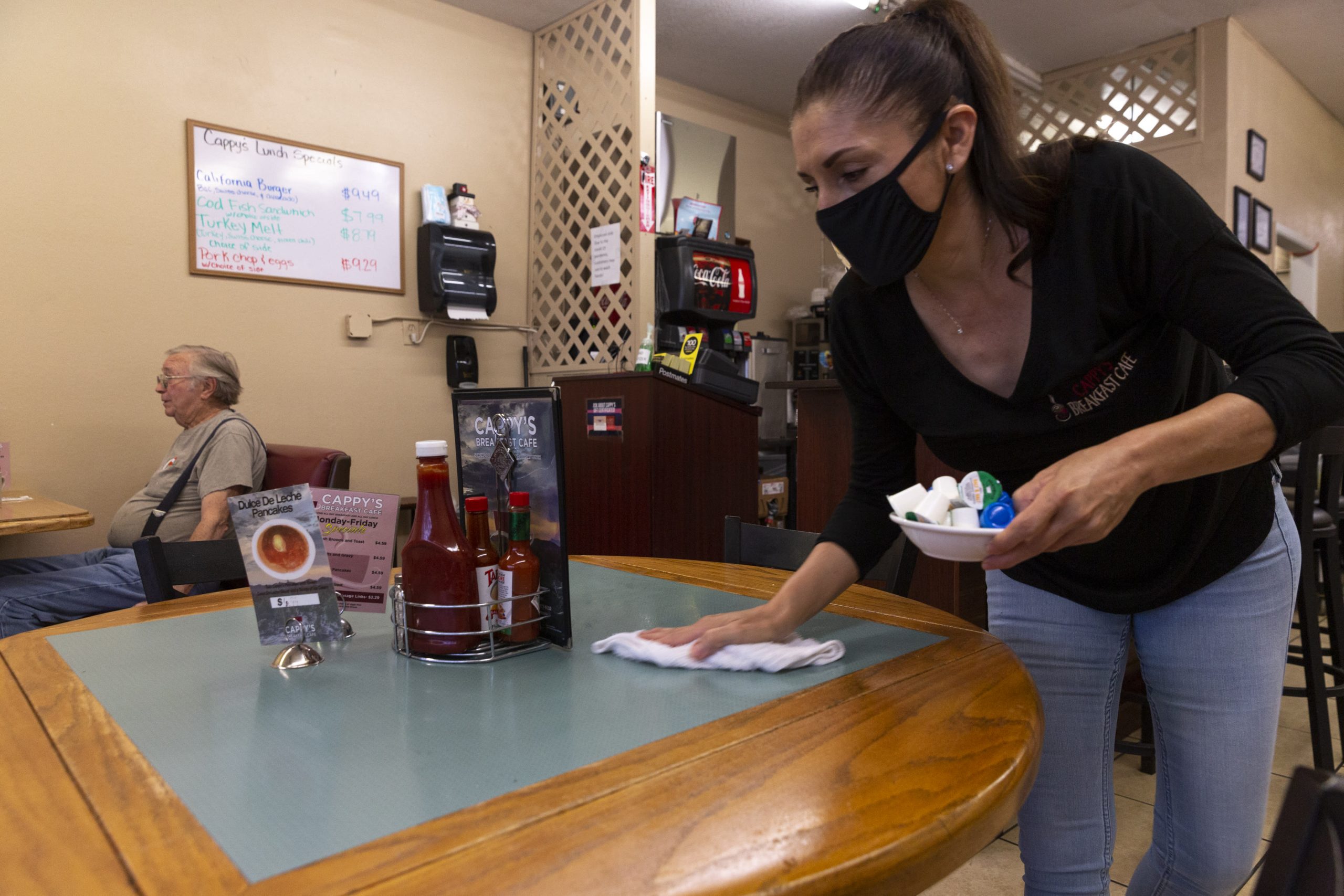An employee wearing a protective mask sanitizes a table at a restaurant in Tucson, Arizona, U.S., on Monday, May 11, 2020.
Cheney Orr | Bloomberg | Getty Images
As state shutdowns are lifted, the focus has turned to whether small to mid-sized businesses are strong enough to reopen and can find enough business to survive.
The concern about solvency was clearly on the mind of Fed Chairman Jerome Powell, when he testified Tuesday before the Senate Banking Committee on the fiscal and monetary programs aimed to help the economy. He reiterated a message he sent last week — that the Fed alone cannot prevent “avoidable insolvencies,” and that Congress needs to help. So far, there’s no agreement on a further stimulus bill in Congress.
There are already signs that businesses in the hardest-hit industries — like restaurants and hotels — are falling behind and not paying their bills at an alarming rate.
“I think what Powell is saying is the solvency side, it has to come from the fiscal side of the equation. The statistics from small business in general show most small businesses operate on a tight cash flow timeline,” said Greg Faranello, head of U.S. rate strategy at AmeriVet Securities.
Small and mid-sized businesses are the backbone of the American workforce, responsible for half the nation’s employment. So, those companies will be critical in reducing unemployment, and jobs will be a big factor in how quickly the economy can recover.
“Timing is really critical here. The virus is a variable. We think we have it contained, and it’s moving in the right direction. We don’t know what will happen in two or three months from now, if it’s moving in the wrong direction,” said Faranello.
Business closures are inevitable in a recession. But this recession is particularly brutal, since the economy was shutdown abruptly and its recovery, for now, depends on businesses being able to operate in a world of social distancing. The recession is also different in that it is the first ever to have started in the service sector, which includes the hotels, restaurants, stores and leisure destinations that were closed when states shut down.
“The other concern is when we talk about the reopenings, how reopened are we really going to become? That depends on how many businesses survive to the other side of the reopenings,” said Mark Zandi, chief economist at Moody’s Analytics. “I think that’s driving these concerns that we’re going to see more business failures.”
There have also been some high profile bankruptcies of large companies, like J.Crew, Neiman Marcus and J.C. Penney’s.
“Bankruptcies and failures are sure to mount. There were approximately 8 million establishments prior to the Covid crisis, and I wouldn’t be surprised if close to 1 million of these firms don’t make it through to the other side of the pandemic,” Zandi said. “Most of these firms will be among the 6.5 million micro businesses with fewer than 10 employees, in the leisure and hospitality, retailing and restaurant industries.”
‘Breaking point’
Zandi said the small firms have little in the way of financial resources and were mostly unable to take advantage of the Paycheck Protection Program, which granted small businesses funds to pay their employees and other expenses.
“Failure means you just put a sign on the door and say ‘I’m closed.’ I think the bankruptcies will be less severe this time around than in the financial crisis,” he said. “That was a year-and-half-long recession and three years of very weak economic growth. I think this is more of a small business problem and there’s going to be more failures.”
The U.S. Travel Association said Tuesday its industry has now lost more than half of its 15.8 million jobs, and the industry’s unemployment rate is about 51%. The industry group said the PPP program has helped travel businesses but it said more stimulative measures are needed.
Businesses in general fell behind on their bills in April, with 29% of payments considered to be late, according to Cortera, which tracks business-to-business spending transactions. That compares with 22% that were late the year earlier.
Zandi said hotel, movie, performing arts and restaurant industries “appear close to a financial breaking point; they are late on about half of their bills.”
Powell said the Fed can address liquidity problems, not solvency problems. “We have lending powers, not spending powers. Over time, and this is not a certainty but possibility, over time solvency problems emerge from the credit problems — from liquidity problems,” he told Congress.
The more failures, the longer the recovery will take and the more difficult it will be to reduce unemployment. In April, 20.5 million jobs were lost, and the unemployment rate jumped to 14.7%.
Many companies may open up partially and only bring back some workers for a downsized business. “They may survive for a while so the failures could linger for a long time until we have a vaccine and things would open more fully,” said Zandi.
Bankruptcies among mid-sized and larger firms will also increase, but they will take longer due to the monetary and fiscal stimulus from the Fed and Congress.
“All of this happened so fast, we can’t even evaluate companies on their recent performance.We don’t have any evidence or proof about companies’ ability to survive,’ said Patrick Leary, chief market strategist at Incapital.
‘What the Fed is saying is they added liquidity, kept things going, but they could have solvency issues as it becomes clear how things changed as the economy opens up,” he said.


 Signal2forex.com - Best Forex robots and signals
Signal2forex.com - Best Forex robots and signals




